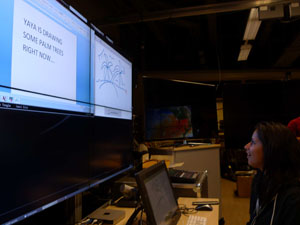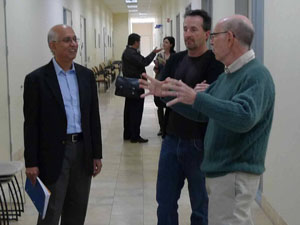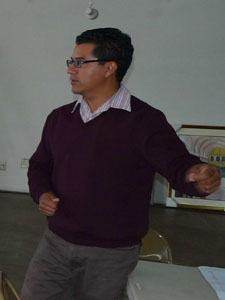OptIPortables Bring High-Tech Collaboration to San Diego Communities
By Tiffany Fox, (858) 246-0353, tfox@ucsd.edu
San Diego, Calif., March 7, 2011 — Two communities in underserved areas of San Diego County have a new tool to improve education and long-distance collaboration, thanks to researchers at the University of California, San Diego, who hope the device will help mitigate at least one problem caused by San Diego’s 4,500 square miles of urban sprawl — the distance between communities.
|
It’s called an OptIPortable, and like a jack-in-the-box, it pops open to reveal a high-resolution, 4-foot by 6-foot wall made of four large, LCD flat screens. The 100-cubic-foot box also includes built-in computers and networking equipment, all of which take less than an hour to get up and running.
Until now, the UC San Diego division of the California Institute for Telecommunications and Information Technology (Calit2) has constructed or helped other universities build their own tiled display walls, because the systems make it easier for users to access, visualize and analyze data remotely. Now the institute is deploying OptIPortables closer to home—helping underserved communities in San Diego to interact with one another and with UCSD, without leaving their own neighborhoods.
The technology is expected to be particularly useful because underserved communities in San Diego are often so geographically distant from academic and commercial centers (and from one another) that it can impede education, job growth and social reform.
“The fundamental idea with the OptIPortable is to promote sharing,” explains Calit2 Director of Visualization Tom DeFanti. “With the OptIPortable, you can walk right up to it and wirelessly push content from your laptop to the screen and then manipulate that data right on the screen. Instead of a group taking turns plugging their laptops into a projector, they can all have their material on the screen at the same time.
“So in a learning situation,” he continues, “it becomes a multi-way collaboration session rather than a one-way lecture. You can hook OptIPortables together with a mouse click to share sessions across town, county, or country, too.”
|
DeFanti and his team will install one OptIPortable wall at the South Metro Career Center (SMCC) in San Diego’s Mount Hope community, and another in San Ysidro at Casa Familiar, a community-based organization focused on understanding the unique challenges faced by underserved communities. The hope is that both organizations will network with one another via their OptIPortables and to Calit2 “to enable communities to share experiences, content and programs with one another and be tightly coupled with UCSD students,” says Srinivas Sukumar, a community outreach director at UC San Diego.
When fully deployed, the OptIPortable displays are about the size of a classroom whiteboard — making them the perfect interface for classroom instruction, job training and community forums. They consist of four 1-megapixel screens, accompanied by a separate television screen for videoconferencing (via LifeSize or Skype) and a 20” tablet for freehand drawing on the big display.
Calit2 is funding the creation and deployment of the systems, which cost $50,000 each. About 1/3 of that cost is for the LifeSize videoconferencing component, which could be replaced by the less expensive but lower-quality Skype. DeFanti estimates that within a few years, the cost for building the OptIPortables will drop to about $10,000, as the price of consumer televisions continues to fall.
The OptIPortables are networked and driven by game computers running a specialized graphics middleware called SAGE (Scalable Adaptive Graphics Environment) which was developed by the Electronic Visualization Laboratory at UIC, a long-time Calit2 collaborator. The only requirements for sharing data on the OptiPortable are a laptop (or even a smartphone or tablet) and a Virtual Network Computing (VNC) app, which can be downloaded off the Internet and installed in minutes.
|
Each array is attached to a custom frame and self-contained motorized system designed by Calit2 Design Engineer Greg Dawe, which incorporates a linear actuator to raise and unfold the display “like a billfold on a push-up popsicle stick,” Dawe says. The OptIportable plugs into a wall outlet but could also run off a portable electric generator. When the OptIPortables are not in use, they fold up and fit inside a wheeled, foam-lined road case, which is small enough to fit through a standard doorway and can be loaded (with the help of a lift or loading dock) onto the back of any pick-up truck.
This emphasis on ease-of-use is purposeful, says Calit2’s Saura Naderi, who — along with Calit2 Research Project Manager Joe Keefe and Calit2 Director of Tours, Trish Stone — oversees the OptIPortable training for staff at SMCC and Casa Familiar, as well as UCSD.
“I didn't know what an OptIPortable was until a month ago and now I'm showing others how to use them,” says Naderi, who now leads the outreach program at UCSD for the Variability Expedition, an NSF-funded program that is exploring variability-aware software for efficient computing with nanoscale devices -- and is bringing hands-on experience with embedded systems and software to K-12 classrooms, especially in underserved communities. “This is proof of how user-friendly these devices are. Staff from SMCC and Casa Familar have learned everything they need to know to be able to break down the machine, move it to another location, build the machine, install the software needed to use the machine and use it to communicate across locations.”
Naderi says the only task left to address is network troubleshooting, which can only reasonably be done on site because each facility presents unique issues. But once that has been addressed, she says the team will reach its training objective: “Sustainability and upkeep of these devices by the staff at each facility, without requiring tech support from Calit2.”
Adds Calit2 Divisional Director at UCSD, Ramesh Rao: “Building OptIPortables is something we’ve been doing at Calit2, typically for our national and international partners in academia and the tech industry. But we have always wanted to assist communities with special needs in our own local region. We are hoping that OptIPortables will enhance UCSD researchers who are focused on community engagement to experiment with new forms of interaction.
“This project also provides opportunities for the people in our San Diego communities to learn new skills in setting up and operating these systems.”
At the SMCC, UCSD Communications Professor Michael Cole is teaching a project-based practicum course for UCSD communications undergrads, who will use the OptIPortable to interact with the local community while they simultaneously learn digital documenting skills, explore various types of computer environments and look at ways to organize activities around media.
In addition, the Center for Community Well-being, an interdisciplinary partnership between UCSD and the community of Southeastern San Diego, will collaborate with UCSD’s Center for Urban Ecologies to help the SMCC and Casa Familiar leverage the OptIPortables to create solutions based on their priorities.
|
“We want to use the OptIPortable to create a digital archive about our community, for example, to gather information on demographics, schools and land, and to use GIS to perform mapping exercises to allow us to better scrutinize how we should be designing and building affordable housing,” explains Flores “We also plan to use it to conduct environmental analyses, such as the effect on air quality of the vehicles idling at the border. We can use these types of data to provide direction for our neighborhood improvement projects.
“I can also see the wall being used for community forums,” he continues, “and we’d also love to integrate the technology into our art exhibits, and perhaps use it as a portal to the Tijuana arts scene, since the border is always present in what we do.
Adds Calit2’s DeFanti: “OptIPortables can virtually teleport people back and forth across the border at the speed of light.”
As for applications outside of education and community development, DeFanti notes that the OptaIPortables could be used for most any collaborative situation, including disaster scenarios that require emergency triage.
“If you can get it in and out of a box in an hour, you can get it deployed and communicating anywhere in San Diego county in a couple of hours,” he says. “The OptIPortable is ideal for any situation that requires data to be shared quickly and easily, by many people — which, when you think about it, is fast becoming a way of life and our concept of community and security.”
Media Contacts
Tiffany Fox, (858) 246-0353, tfox@ucsd.edu
Related Links
South Metro Career Center
Casa Familiar
Variability Expedition


.jpg)


